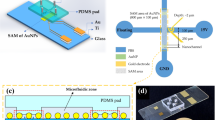Abstract
This paper investigated the effects of ionic strength in the medium on a preconcentrator for a protein sample with low concentration. The preconcentration chip was designed and fabricated using a polydimethylsiloxane replica through standard lithophotography. A glass substrate is silanized prior to functionalizing the nanoparticles for self-assembly at a designed region. Due to the overlap of electrical double layers in a nanofluidic channel, a concentration polarization effect can be achieved using an electric field. A nonlinear electrokinetic flow is induced, resulting in the fast accumulation of proteins in front of the induced ionic depletion zone, so called exclusion-enrichment effect. Thus, the protein sample can be driven by electroosmotic flow and accumulated at a specific location. The chip is used to collect fluorescein isothiocyanate-labeled bovine serum albumin (FITC-BSA) diluted in phosphate- buffered saline (PBS) buffer solution. Different concentrations of the buffer media were studied herein. Fluorescence intensity images show that the buffer concentration of 4 mM is more appropriate than all the other ones. The sample of FITC-BSA with an initial concentration of 10 μM in the 4 mM PBS solution increases its concentration at the desired region by up to 50 times within 30 min, demonstrating the results in this investigation.
Similar content being viewed by others
References
Lin, C.C., Hsu, J.L. & Lee, G. Bin. Sample preconcentration in microfluidic devices. Microfluid. Nanofluid. 10, 481–511 (2011).
Islam, M.R. & Serpe, M.J. Label-free detection of low protein concentration in solution using a novel colorimetric assay. Biosens. Bioelectron. 49, 133–138 (2013).
Koh, Y. et al. Nanoslit-concentration-chip integrated microbead-based protein assay system for sensitive and quantitative detection. RSC Adv. 7, 29679–29685 (2017).
Wang, C., Shi, Y., Wang, J., Pang, J. & Xia, X.H. Ultrasensitive protein concentration detection on a micro/nanofluidic enrichment chip using fluorescence quenching. ACS Appl. Mater. Interfaces 7, 6835–6841 (2015).
Duan, C., Wang, W. & Xie, Q. Review article: Fabrication of nanofluidic devices. Biomicrofluidics 7, 026501 (2013).
Wang, Y.C., Stevens, A.L. & Han, J. Million-fold preconcentration of proteins and peptides by nanofluidic filter. Anal. Chem. 77, 4293–4299 (2005).
Wu, D. & Steckl, A.J. High speed nanofluidic protein accumulator. Lab Chip 9, 1890 (2009).
Wang, J., Zhang, L., Xue, J. & Hu, G. Ion diffusion coefficient measurements in nanochannels at various concentrations. Biomicrofluidics 8, 1 (2014).
Kim, S.M., Burns, M.A. & Hasselbrink, E.F. Electrokinetic protein preconcentration using a simple glass/poly (dimethylsiloxane) microfluidic chip. Anal. Chem. 78, 4779–4785 (2006).
Jeong, H.L., Chung, S., Sung, J.K. & Han, J. Poly(dimethylsiloxane)-based protein preconcentration using a nanogap generated by junction gap breakdown. Anal. Chem. 79, 6868–6873 (2007).
Yang, R.-J., Pu, H.-H. & Wang, H.-L. Ion concentration polarization on paper-based microfluidic devices and its application to preconcentrate dilute sample solutions. Biomicrofluidics 9, 014122 (2015).
Lee, J.H., Song, Y.-A. & Han, J. Multiplexed proteomic sample preconcentration device using surface-patterned ion-selective membrane. Lab Chip 8, 596 (2008).
Syed, A., Mangano, L., Mao, P., Han, J. & Song, Y. Creating sub-50 nm nanofluidic junctions in a PDMS microchip via self-assembly process of colloidal silica beads for electrokinetic concentration of biomolecules. Lab Chip 14, 4455–4460 (2014).
Jen, C.P., Amstislavskaya, T.G., Kuo, C.C. & Chen, Y.H. Protein preconcentration using nanofractures generated by nanoparticle-assisted electric breakdown at junction gaps. PLoS ONE 9, e102050 (2014).
Jen, C.P., Amstislavskaya, T.G., Chen, K.F. & Chen, Y.H. Sample preconcentration utilizing nanofractures generated by junction gap breakdown assisted by self-assembled monolayer of gold nanoparticles. PLoS ONE 10, e0126641 (2015).
Pu, Q., Yun, J., Temkin, H. & Liu, S. Ion-enrichment and ion-depletion effect of nanochannel structures. Nano Lett. 4, 1099–1103 (2004).
Quoc, T.V., Wu, M.S., Bui, T.T., Duc, T.C. & Jen, C.P. A compact microfluidic chip with integrated impedance biosensor for protein preconcentration and detection. Biomicrofluidics 11 (2017).
Mani, A., Zangle, T.A. & Santiago, J.G. On the propagation of concentration polarization from microchannelnanochannel interfaces Part I: Analytical model and characteristic analysis. Langmuir 25, 3898–3908 (2009).
Rohani, A. et al. Frequency-selective electrokinetic enrichment of biomolecules in physiological media based on electrical double-layer polarization. Nanoscale 9, 12124–12131 (2017).
Rohani, A., Varhue, W., Liao, K. & Chou, C. Nanoslit design for ion conductivity gradient enhanced dielectrophoresis for ultrafast biomarker enrichment in physiological media. Biomicrofluidics 10, 033109 (2016).
Chun, H., Chung, T.D. & Ramsey, J.M. High yield sample preconcentration using a highly ion-conductive charge-selective polymer. Anal. Chem. 82, 6287–6292 (2010).
Jung, B., Bharadwaj, R. & Santiago, J.G. On-chip millionfold sample stacking using transient isotachophoresis. Anal. Chem. 78, 2319–2327 (2006).
Hofmann, O., Che, D., Cruickshank, K.A. & Muller, U.R. Adaptation of capillary isoelectric focusing to microchannels on a glass chip. Anal. Chem. 71, 678–686 (1999).
Schrott, W. et al. Study on surface properties of PDMS microfluidic chips treated with albumin. Biomicrofluidics 3, 1–15 (2009).
Linder, V., Verpoorte, E., Thormann, W., De Rooij, N.F. & Sigrist, H. Surface biopassivation of replicated poly (dimethylsiloxane) microfluidic channels and application to heterogeneous immunoreaction with on-chip fluorescence detection. Anal. Chem. 73, 4181–4189 (2001).
Oldham, K.B. A Gouy-Chapman-Stern model of the double layer at a (metal)/(ionic liquid) interface. J. Electroanal. Chem. 613, 131–138 (2008).
Brown, M.A., Goel, A. & Abbas, Z. Effect of electrolyte concentration on the stern layer thickness at a charged interface. Angew. Chem. Int. Ed. 55, 3790–3794 (2016).
Author information
Authors and Affiliations
Corresponding author
Rights and permissions
About this article
Cite this article
Nguyen, NV., Wu, JS. & Jen, CP. Effects of Ionic Strength in the Medium on Sample Preconcentration Utilizing Nano-interstices between Self-Assembled Monolayers of Gold Nanoparticles. BioChip J 12, 317–325 (2018). https://doi.org/10.1007/s13206-018-2402-1
Received:
Accepted:
Published:
Issue Date:
DOI: https://doi.org/10.1007/s13206-018-2402-1




